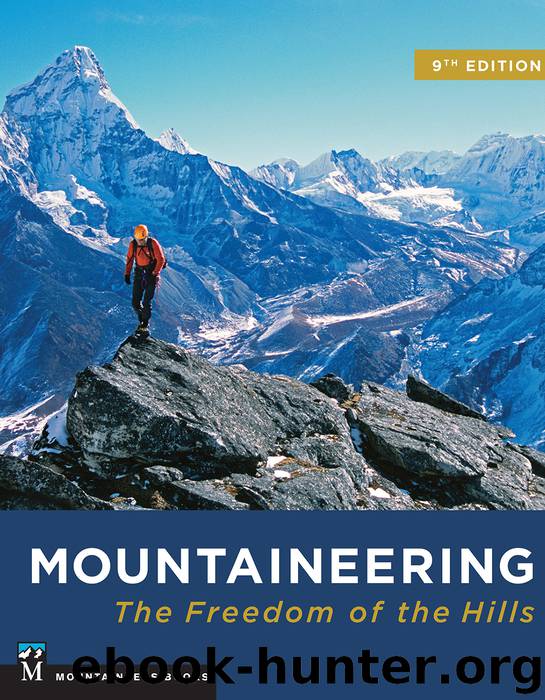Mountaineering by The Mountaineers

Author:The Mountaineers
Language: eng
Format: epub
ISBN: 9781680510058
Publisher: Mountaineers Books
Published: 2017-06-03T04:00:00+00:00
Fig. 15-16. Piton placements: a, placements are best if crack constricts above and below piton; b, safely extending a piton to avoid cross-loading the carabiner; c, angle piton placements should have all three points in contact with the rock.
Fig. 15-17. Examples of pitons and angles stacked and nested (some keeper slings omitted for clarity): a, arrow and knifeblade stacked back-to-back; b, Leeper Z and angle, nested; c, two arrows and knifeblade, stacked.
HOOK PLACEMENT AND USE
To place a hook, set the hook on the ledge, flake, or hole where it will be used. When learning, try several hooks to see which one sits most securely in the feature. Move the hook around to try to find the most secure positioning by feel, and if the hooked feature can be seen, visually inspect the quality of the placement as well. Hooks can sometimes be placed on top of a fixed copperhead that has lost its wire (called a “dead head”).
After selecting the hook and placement position, clip an aider and daisy chain to the hook. Test all hooks before applying full body weight (or gently “ooze” body weight onto the hook if it is off to the side or otherwise cannot be tested). Climbers usually start very low in their aiders so that their weight and stance are well below the hook before they move up the aiders one step at a time. Climbers should avoid standing with their face directly in front of the hook because it could pop out with a good deal of force. Once your weight is on the hook in one aider (or one pair), it can be helpful to “fifi in”—to hook in to the aider’s carabiner and hang your body weight—just as with other pieces of protection. Always keep constant downward pressure on the hook when standing in the aiders, especially when moving up in the aiders and switching weight from one foot to the other.
Cam hooks should be placed in the crack or pocket in a fashion that will make the hook bind up and rotate to cause a camming force on the rock. These placements rely on the force created by the torque (camming action) of the hook into the rock. With practice, cam hooks can be placed in many seemingly unlikely positions and orientations. The tighter the cam hook fits into the crack (in other words, the closer the width of the metal sheet is to the width of the crack), the more secure the placement and the less potential there is to do any damage to the rock. A cam hook can be hit once with a hammer to increase the placement’s security when needed. Sometimes a hammer is needed to remove a cam hook, even when it has supported only body weight. Climbers generally agree that cam hooks should not be used in certain rock, such as sandstone, because they may damage the rock with their camming action.
MALLEABLE PLACEMENTS
Because climbers often cannot tell how secure the placements of malleable heads
Download
This site does not store any files on its server. We only index and link to content provided by other sites. Please contact the content providers to delete copyright contents if any and email us, we'll remove relevant links or contents immediately.
Annapurna by Maurice Herzog(3301)
Into Thin Air by Jon Krakauer(3132)
SAS Survival Handbook by John 'Lofty' Wiseman(2583)
The Ogre by Doug Scott(2506)
Reservoir 13 by Jon McGregor(2148)
Everest the Cruel Way by Joe Tasker(2135)
The End of Eddy by Édouard Louis(2056)
Touching the Void by Joe Simpson(1975)
The Push by Tommy Caldwell(1929)
Iced In by Chris Turney(1853)
The Isle of Mull by Terry Marsh(1806)
Miracle in the Andes by Nando Parrado(1793)
The Call of Everest by Conrad Anker(1788)
Touching the Void (1987) by Joe Simpson(1706)
Mud, Sweat, and Tears by Bear Grylls(1546)
Himalaya Bound by Michael Benanav(1511)
Higher Calling by Max Leonard(1476)
Death Grip by Matt Samet(1383)
Backcountry Bear Basics by Dave Smith(1361)
